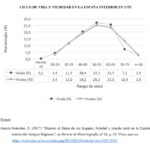The graph shows the life cycle of widows. It shows that their proportion peaks between the ages of 50 and 60 with 27.2%. This remains stable at around 25.7% in the next decade of their lives, between 60 and 70. This is not the case from the age of 70 onwards, when mortality increases considerably, leading to a downward trend. In comparison, the life cycle of widowers evolves in a similar way, although at later ages we observe how they tended to be more lonely than women, a behaviour that can be explained by the fact that mothers, more than fathers, would go on to live with their children.
Collection: Graphics
Project: 3. Rural world and urban world in the formation of the European identity., 4. Family, daily life and social inequality in Europe.
Chronology: XVIII
Scope: Secondary Education, Baccalaureate, University
Link: https://e-revistas.uc3m.es/index.php/REVHISTO/article/view/3697/2303
Resource type: Graph
Format: Line chart
Source: García González, F. (2017) “Mujeres al frente de sus hogares. Soledad y mundo rural en la España interior del Antiguo Régimen”, en Revista de Historiografía, nº 26, p. 33
Language: Spanish
Date: 2017
Owner: Pablo Ballesta Fernández (Modernalia)
Copyright: © Instituto de Historiografía "Julio Caro Baroja" de la Universidad Carlos III ©Francisco García González ©Seminario de Historia Social de la Población
Abstract: Life cycle of widowers showing its peak at the ages of maturity
Image
Tags








